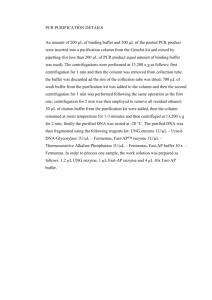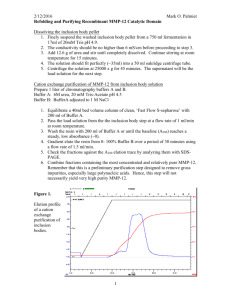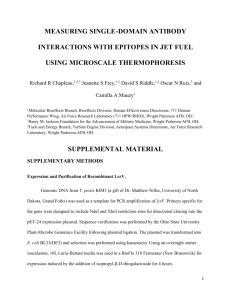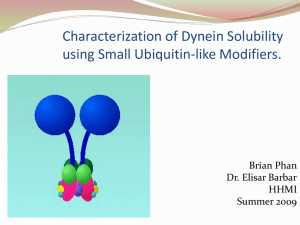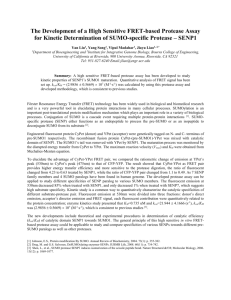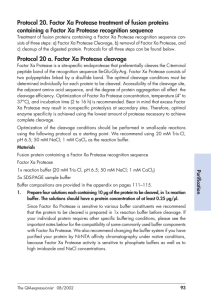PRO_516_sm_suppinfo1
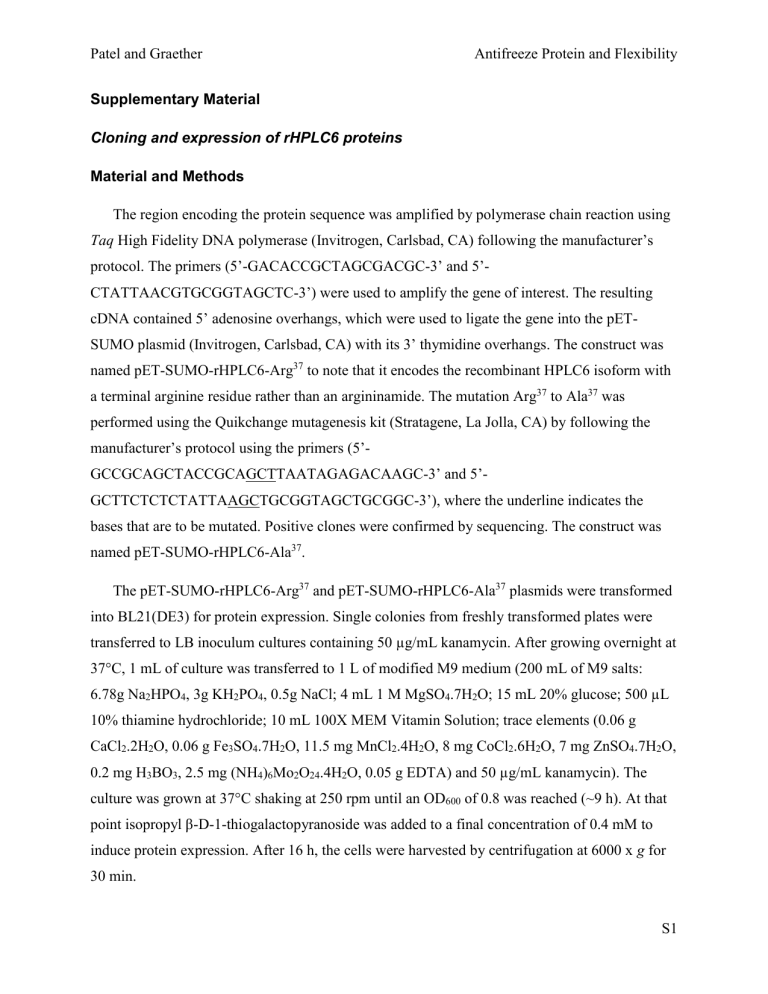
Patel and Graether Antifreeze Protein and Flexibility
Supplementary Material
Cloning and expression of rHPLC6 proteins
Material and Methods
The region encoding the protein sequence was amplified by polymerase chain reaction using
Taq High Fidelity DNA polymerase (Invitrogen, Carlsbad, CA) following the manufacturer’s protocol. The primers (5’-GACACCGCTAGCGACGC-3’ and 5’-
CTATTAACGTGCGGTAGCTC-3’) were used to amplify the gene of interest. The resulting cDNA contained 5’ adenosine overhangs, which were used to ligate the gene into the pET-
SUMO plasmid (Invitrogen, Carlsbad, CA) with its 3’ thymidine overhangs. The construct was named pET-SUMO-rHPLC6-Arg
37
to note that it encodes the recombinant HPLC6 isoform with a terminal arginine residue rather than an argininamide. The mutation Arg
37
to Ala
37
was performed using the Quikchange mutagenesis kit (Stratagene, La Jolla, CA) by following the manufacturer’s protocol using the primers (5’-
GCCGCAGCTACCGCAGCTTAATAGAGACAAGC-3’ and 5’-
GCTTCTCTCTATTAAGCTGCGGTAGCTGCGGC-3’), where the underline indicates the bases that are to be mutated. Positive clones were confirmed by sequencing. The construct was named pET-SUMO-rHPLC6-Ala
37
.
The pET-SUMO-rHPLC6-Arg
37
and pET-SUMO-rHPLC6-Ala
37
plasmids were transformed into BL21(DE3) for protein expression. Single colonies from freshly transformed plates were transferred to LB inoculum cultures containing 50 µg/mL kanamycin. After growing overnight at
37°C, 1 mL of culture was transferred to 1 L of modified M9 medium (200 mL of M9 salts:
6.78g Na
2
HPO
4
, 3g KH
2
PO
4
, 0.5g NaCl; 4 mL 1 M MgSO
4
.7H
2
O; 15 mL 20% glucose; 500 µL
10% thiamine hydrochloride; 10 mL 100X MEM Vitamin Solution; trace elements (0.06 g
CaCl
2
.2H
2
O, 0.06 g Fe
3
SO
4
.7H
2
O, 11.5 mg MnCl
2
.4H
2
O, 8 mg CoCl
2
.6H
2
O, 7 mg ZnSO
4
.7H
2
O,
0.2 mg H
3
BO
3
, 2.5 mg (NH
4
)
6
Mo
2
O
24
.4H
2
O, 0.05 g EDTA) and 50 µg/mL kanamycin). The culture was grown at 37°C shaking at 250 rpm until an OD
600
of 0.8 was reached (~9 h). At that point isopropyl β-D-1-thiogalactopyranoside was added to a final concentration of 0.4 mM to induce protein expression. After 16 h, the cells were harvested by centrifugation at 6000 x g for
30 min.
S1
Patel and Graether Antifreeze Protein and Flexibility
The cell pellet was resuspended in 20 mL of column binding buffer (20 mM Tris, pH 8.0,
500 mM NaCl, 10 mM imidazole) in the presence of HALT protease inhibitor cocktail (Fisher
Scientific, Rockford, IL). Extraction of the fusion protein was performed by lysing the cells using pulse sonication for 5 x 1 min with a 50% duty cycle. Cellular debris and insoluble proteins were removed by centrifugation at 50,000 x g for 30 min. The supernatant was filtered using a 0.22 µm filter (Millipore, Billerica, MA) before purification using a nickel affinity column (Histrap HP, GE Healthcare Canada, Baie d’Urfe, Quebec), with a linear gradient of 10 column volumes between the binding buffer and the elution buffer (20 mM Tris, pH 8.0, 500 mM NaCl, 500 mM imidazole). Fractions containing pure SUMO-rHPLC6-Arg
37
or SUMOrHPLC6-Ala
37
fusion proteins (as assessed by a Tris-tricine gel) were pooled and exhaustively dialyzed against 20 mM Tris, pH 8.0, 150 mM NaCl. The SUMO domain was cleaved using either commercial SUMO Protease (Lifesensor, Malvern, PA) or recombinantly purified SUMO protease (from a pET-28b plasmid with the Ulp coding region (403-621), a generous gift from
Christopher Lima, Cornell University, and the Cornell Research Foundation)(55). The protease buffer contained 20 mM Tris, pH 8.0, 150 mM NaCl, 10% glycerol and 2 mM dithiothreitol. In order to obtain nearly complete cleavage (>98%) of the SUMO-AFP1 fusion proteins, the protease was added in an enzyme:protein (w/w) ratio of 1:500. The reaction was incubated at
30°C for 1 h before being moved to 4°C overnight. The cleaved rHPLC6-Arg 37
and rHPLC6-
Ala
37
were separated from cleaved and uncleaved SUMO proteins and SUMO protease by purification using the nickel affinity column under the same conditions as in the first purification step. Flow through fractions containing the antifreeze protein were then purified by reversedphase HPLC using a C18 column (Fisher Scientific, Rockford, IL) with buffer A (0.1% trifluoroacetic acid (w/v) in water) and buffer B (0.1% trifluoroacetic acid (w/v) in acetonitrile).
Separation was performed using a linear gradient of 25% buffer B to 100% buffer B over 20 min.
Fractions containing rHPLC6-Arg 37 or rHPLC6-Ala 37 were lyophilized for storage.
Results
The use of a SUMO-fusion facilitates protein purification via the N-terminal His
6
tag, and, in combination with the SUMO-protease (55), results in a native N-terminal residue and cap structure. Expression of the pET-SUMO-rHPLC6-Ala
37
and pET-SUMO-rHPLC6-Arg
37
in M9
S2
Patel and Graether Antifreeze Protein and Flexibility minimal media resulted in yields of 15-20 mg of fusion protein per liter after nickel affinity purification, while cleavage of the type I AFP domain from the SUMO domain resulted in 3-4 mg of antifreeze protein per liter of medium (Figure S1 A ). Cleavage was >98% complete as assessed by SDS-PAGE. Reversed-phase HPLC removed residual protein contaminants and resulted in a sample that was >95% pure (Figure S1 B ). Mass spectrometry confirmed the protein to be rHPLC6-Ala
37
(3157
3 Da versus a predicted value of 3157 Da) and rHPLC6-Arg
37
(3242
3 Da versus a predicted value of 3242 Da). Reversed-phase HPLC of the CPD-Y treated protein resulted in several uncharacterized species, and the correctly amidated rHPLC6 (Figure
S2).
References
55. Reverter, D., and C. D. Lima. 2009. Preparation of SUMO proteases and kinetic analysis using endogenous substrates. Methods in Molecular Biology (Clifton, N.J) 497:225-239.
S3
Patel and Graether Antifreeze Protein and Flexibility
Figure S1.
Purification of rHPLC6. (A) Expression, purification, and cleavage of SUMOrHPLC6-Ala
37
. The same results were obtained for the SUMO-rHPLC6-Arg
37
construct. The molecular weights of the marker proteins are indicated on the left. Lane 1, molecular weight marker; lane 2, whole cell, pre-induction; lane 3, whole cell, post-induction; lane 4, sample loaded onto the Histrap column; lane 5, pooled sample after Histrap column; lane 6, cleaved fusion protein after SUMO protease treatment. The arrow shows the expected location of the
SUMO-rHPLC6 fusion protein, while the asterisk marks the location of an uncharacterized contaminant. (B) Purity of rHPLC6-Ala
37
. The purity of the rHPLC6-Ala
37
sample after reversed-phase HPLC6 was examined by loading 300
g of protein onto the column. The solid line represents the absorbance of the sample at 214 nm and the dashed line represents the percent of buffer B.
S4
Patel and Graether Antifreeze Protein and Flexibility
Figure S2.
Purification of rHPLC6. The rHPLC6 was separated from other products after carboxypeptidase-Y treatment by reversed-phase HPLC. The vertical arrow shows the recombinant protein that eluted at the same position as synthetic HPLC6, and has a molecular mass identical to that of HPLC6. The solid line represents the absorbance of the sample at 214 nm and the dashed line represents the percent of buffer B.
S5

